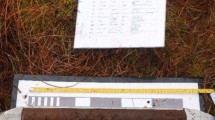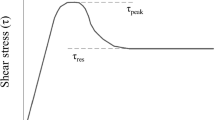Abstract
The ASTM standard provides guidelines for the drained direct shear test (DST) and requires the samples to be sheared at rates estimated from time to failure, \(t_{f} \ge 50t_{50}\) (where \(t_{50}\) is the time required to achieve 50% consolidation). This paper investigates the potential of estimating the undrained strength of peat in the DST owing to its ease of accessibility and simplicity over other laboratory tests. In this experimental study, peat samples were sheared at various displacement rates at \(t_{f} /t_{50}\) values of 0.065–70. The samples tested at the ASTM specified rate of \(t_{f} \ge 50t_{50}\) exhibit continuous increase and decrease in shear stress and volume respectively with increasing shear strain. Hence, determining the drained strength properties of peat in the DST apparatus is complicated. However, it is concluded that the shear stress ratio, \(\tau /\sigma {^\prime }_{v}\) of the DST test samples sheared at rates corresponding to \(t_{f} \le 0.2t_{50}\), reasonably corresponds to that measured in undrained direct simple shear (DSS) tests on peat, found in the literature. Therefore, DST conducted at high displacement rates will be adequate for preliminary evaluation of the shear strength of peat at close to undrained conditions, when constant volume DSS apparatus is not available.









Similar content being viewed by others
References
American Society for Testing and materials (2011) Annual Book of ASTM Standards, vol. 4.08. Designation: D 3080/D 3080M- 11, Standard Test Method for Direct Shear Test of Soils Under Consolidated Drained Conditions, vol. 4.08. Annual Book of ASTM Standards
ASTM D854-02 (2014) Standard test methods for specific gravity of soil solids by water pycnometer 1. ASTM Standard Guide, vol 4, pp 1–8
ASTM D1997–13 (2013) Standard test method for laboratory determination of the fiber content of peat samples by dry mass. ASTM International, West Conshohocken
ASTM D2794 (2007) Standard test methods for moisture, ash, and organic matter of peat and other organic soils. ASTM International, West Conshohocken
ASTM D6528–07 (2007) Consolidated undrained direct simple shear testing of cohesive soils. STM International, West Conshohocken, pp 1–9
Boylan N, Long M (2013) Evaluation of peat strength for stability assessments. Proc ICE Geotech Eng 166:1–10
Boylan N, Jennings P, Long M (2008) Peat slope failure in Ireland. Q J Eng Geol Hydrogeol 41(1):93–108
Bro AD, Stewart JP, Pradel D (2013) Estimating undrained strength of clays from direct shear testing at fast displacement rates. Geo-Congress 2013:106–119
Casagrande A, Fadum RE (1940) Notes on soil testing for engineering purposes, vol 8. Harvard Soil Mechanics. Harvard University, Cambridge
Den Haan E, Feddema A (2012) Deformation and strength of embankments on soft Dutch soil. Proc ICE Geotech Eng 166(3):239–252
Den Haan EJ, Kruse GAM (2007) Characterisation and engineering properties of Dutch peats. In: Proceedings of characterisation and engineering properties of natural soils, Singapore, pp 2101–2133
Grognet M (2011) The boundary conditions in direct simple shear tests: developments for peat testing at low normal stress. M.Sc. Thesis, 92
Hanzawa H, Nutt N, Lunne T, Tang YX, Long M (2007) A comparative study between the NGI direct simple shear apparatus and the MIKASA direct Shear apparatus. Soils Found 47:47–58
Hendry MT, Sharma JS, Martin CD, Barbour SL (2012) Effect of fibre content and structure on anisotropic elastic stiffness and shear strength of peat. Can Geotech J 49(4):403–415
ISSMFE (1981) International manual for the sampling of soft cohesive materials. Published by Tokai Universtiy Press, Tokyo on behalf of the International Society of Soil Mechanics and Foundation Engineering
Ladd CC (1991) Stability evaluation during staged construction. J Geotech Eng 117(4):540–615
Landva AO (1986) In situ testing of peat. ASCE Spec Geotech Publ 6:191–205
Landva A, La Rochelle P (1983) Compressibility and shear characteristics of radforth peats. In: Testing peat organic soils, ASTV STP
Landva AO, Korpijaakko EO, Pheeney PE (1983) Geotechnical classification of peats and organic soils. Am Soc Test Mater 20(8):37–51
Long M (2005) Review of peat strength peat characterisation and constitutive modelling of peat with reference to landslides. Studia Geotechnica et Mechanica 27(3–4):67–90
Long M, Jennings P (2006) Analysis of the peat slide at Pollatomish, County Mayo, Ireland. Landslides 3:51–61
McInerney GP, O’Kelly BC, Johnston PM (2006) Geotechnical aspects of peat dams on bog land. In: Proceedings 5th international congress on environmental geotechnics, Cardiff
Moore PD, Bellamy DJ (1974) Peatlands (illustrate). Springer, Berlin
O’Kelly B (2014) Effective stress strength testing of peat. Environ Geotech 13(112):1–11
O’Kelly BC (2017) Measurement, interpretation and recommended use of laboratory strength properties of fibrous peat. Geotech Res 4(3):136–171
Pichan S, O’Kelly BC (2012) Effect of decomposition on the compressibility of fibrous peat. In: GeoCongress
Van Baars S (2005) The horizontal failure mechanism of the Wilnis peat dyke. Geotechnique 55(4):319–323
Von Post L, Granlund E (1926) Peat resources in southern Sweden I. Sveriges Geologiska Undersökning 335:1–128
Zhang L, O’Kelly BC (2014) The principle of effective stress and triaxial compression testing of peat. Proc ICE Geotech Eng 167(1):40–50
Zwanenburg C, Den Haan EJ, Kruse GAM, Koelewijn AR (2012) Failure of a trial embankment on peat in Booneschans, the Netherlands. Géotechnique 62(6):479–490
Acknowledgements
The work presented in this paper is supported by the UNIMAS small Grant Scheme (Grant No. FO2(S165)/1198/2015(02)) and the Fundamental Research Grant Scheme (Grant No. FRGS/TK01(02)/1302/2015(19)). The authors are very grateful to Mohd Nazri Zaidan, an intern student at the Universiti Malaysia Sarawak for his helping hand during the experiment. Also, Haji Affandi and all other geotechnical laboratory technicians are gratefully acknowledged for their support and time. The second author is grateful for the postdoctoral fellowship financial support in COFS, UWA, provided by the ARC Industrial Transformation Research Hub for Offshore Floating Facilities (funded by Australian Research Council).
Author information
Authors and Affiliations
Corresponding author
Rights and permissions
About this article
Cite this article
Amuda, A.G., Sahdi, F., Hasan, A. et al. Measurement of Amorphous Peat Shear Strength in the Direct Shear Box at High Displacement Rates. Geotech Geol Eng 37, 1059–1072 (2019). https://doi.org/10.1007/s10706-018-0643-3
Received:
Accepted:
Published:
Issue Date:
DOI: https://doi.org/10.1007/s10706-018-0643-3




